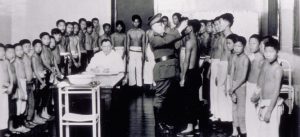A review by Luis Melgar

Biotypologist Examining an Indigenous Person
Between the 1920s and the 1960s, Mexico underwent many changes in power and governance and in its struggle to find unity and cohesion sought to establish a racialized system that would create a Mexican identity which would serve as a model for the world. This seemed to be more viable and less abhorrent at the time with the use of biotypology, a form of classifying human characteristics, instead of castes with the aim of simplifying Mexico. Ultimately, this system and many before it would fail in its attempts and would only further complicate the turbulent mapping of a 20th century Mexico.
This reading is a secondary source because it was published in 2003 and cites time periods and theories from the early to mid-20th century. This source was created as an attempt to follow and find the path that Mexico took in its attempt to find its identity.
Mestizophilia to Biotypology is a reading that contributes to “Indigeneity in Mexico” very well because it reviews key time periods that shaped how Indigeneity is perceived and categorized throughout 4 main time periods: the Porfiriato (1876-1910), the Mexican Revolution (1910-1920), the postrevolutionary movement (1920-1940) and the Partido Revolucionario Institucional era (1940-60s) p.188
The reading was well researched and incorporates various schools of thoughts and theories that were emphasized during each of the time periods mentioned. The introduction was confusing initially, but after having completed the reading, I was able to read and understand the introduction in a new light. It tells a compelling story that follows mexico’s complex racial timeline. The examples cited are relevant and effective. It does require that the reader have a background in Mexican history to make sense of the references used, but thankfully we have had that in our course thus far.
I also feel that a diagram or chart that gives a clear and visual timeline that I could follow easily would add to this chapter and illustrate the racialization shifts in Mexico well. This may be difficult due to the constantly changing Mexican racial landscape. The author mentions this early on in the reading and reiterates this in the conclusion once again. Nonetheless, the reading was easy to follow.
It is clear that much time and effort was put into the eugenic and biotypological “research”. It has certain elements and influences from other factors such as Comte’s Positivism, Lamarck’s Theory, Mendelism from the 1940s.
Why do you think that there was so much emphasis and stress on identifying a people or group of people?
What do you think occurred after biotypology and where does that leave Mexico, in particular, today?
